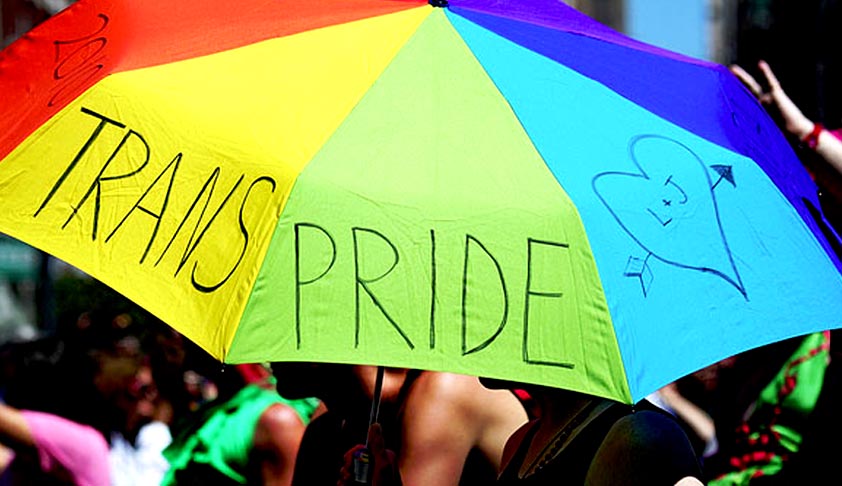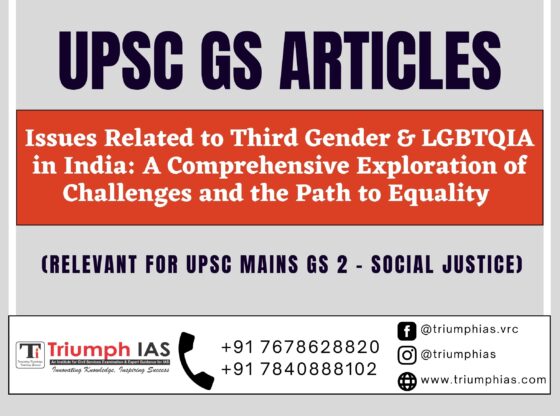Relevant for UPSC Mains GS 2 – Social Justice

Introduction: The recognition and acceptance of the third gender and LGBTQIA (Lesbian, Gay, Bisexual, Transgender, Queer, Intersex, and Asexual) community have been a longstanding struggle worldwide. In India, the journey towards equality has been marked by legal battles, social stigmatization, and discrimination. This extensive blog will delve into the challenges faced by the third gender and LGBTQIA community, explore the legal and social landscape, and discuss potential solutions to address these issues in India.
- Understanding Third Gender & LGBTQIA in India: The term “third gender” refers to people who do not identify as male or female, encompassing transgender, hijra, and other gender-nonconforming individuals. The LGBTQIA community includes people who identify as lesbian, gay, bisexual, transgender, queer, intersex, and asexual, as well as others who do not fit within the conventional binary gender or sexual orientation categories. In India, the third gender and LGBTQIA community has long been marginalized and subjected to discrimination, stigma, and exclusion. However, recent legal advancements and growing social awareness have paved the way for positive change, offering hope for greater acceptance and equality.
- Legal Landscape for Third Gender & LGBTQIA in India: India’s legal landscape regarding the third gender and LGBTQIA rights has evolved significantly in recent years, with landmark judgments and legislative changes contributing to the recognition and protection of their rights:
- National Legal Services Authority (NALSA) v. Union of India (2014): In this landmark judgment, the Supreme Court of India recognized the rights of transgender individuals and granted them legal recognition as the “third gender.” The judgment also mandated the government to provide them with equal opportunities in education, employment, healthcare, and social welfare.
- Section 377 of the Indian Penal Code: In 2018, the Supreme Court of India decriminalized consensual homosexual acts between adults by striking down Section 377, a colonial-era law that criminalized “unnatural offenses.” This historic judgment marked a significant step towards the recognition of LGBTQIA rights in India.
- The Transgender Persons (Protection of Rights) Act, 2019: This Act seeks to protect the rights of transgender persons by prohibiting discrimination in education, employment, healthcare, and other areas. The Act also provides for the establishment of a National Council for Transgender Persons to advise the government on relevant policies and legislation.
- Despite these legal advancements, there are still gaps in the legal framework and implementation, which need to be addressed to ensure the full realization of third gender and LGBTQIA rights in India.
- Challenges Faced by Third Gender & LGBTQIA Community in India: The third gender and LGBTQIA community in India continues to face several challenges that hinder their path towards equality and social acceptance.
- Social Stigma and Discrimination: Members of the third gender and LGBTQIA community often face social stigma, discrimination, and exclusion in various aspects of their lives, including family, education, employment, and public spaces. This discrimination often results in social isolation, mental health issues, and limited opportunities for growth and development.
- Violence and Harassment: Members of the third gender and LGBTQIA community are frequently subjected to violence, harassment, and abuse, both from family members and society at large. Transgender individuals, in particular, often experience physical and sexual violence, which exacerbates their vulnerability and marginalization.
- Limited Access to Education and Employment Opportunities: Discrimination and exclusion often hinder access to education and employment opportunities for the third gender and LGBTQIA community. Lack of access to quality education and limited job opportunities contribute to economic instability and poverty for many members of this community.
- Healthcare Disparities: Members of the third gender and LGBTQIA community often face unique health challenges and disparities, including limited access to healthcare services, discrimination by healthcare providers, and inadequate coverage of their specific health needs. Mental health issues, such as depression and anxiety, are also more prevalent due to social exclusion, discrimination, and violence.
- Legal Gaps and Implementation Challenges: Despite the legal advancements, there are still gaps in the legal framework and challenges in implementation, which need to be addressed to ensure the full realization of third gender and LGBTQIA rights in India. For instance, the Transgender Persons (Protection of Rights) Act, 2019, has been criticized for its lack of clarity regarding self-identification and the process of obtaining a legal gender change.
- Potential Solutions to Address Issues Faced by Third Gender & LGBTQIA Community in India: To effectively address the challenges faced by the third gender and LGBTQIA community in India, a multi-pronged approach involving various stakeholders is needed.
- Strengthening Legal Framework and Implementation: Addressing the gaps in the legal framework and improving the implementation of existing laws and policies can help protect the rights of the third gender and LGBTQIA community. This includes refining the Transgender Persons (Protection of Rights) Act, 2019, and ensuring effective enforcement of anti-discrimination and hate crime laws.
- Awareness and Sensitization Programs: Initiatives aimed at raising awareness about the third gender and LGBTQIA community, and promoting understanding and empathy among the general population, can help challenge societal prejudices and foster acceptance. Sensitization programs targeting key stakeholders, such as law enforcement personnel, healthcare providers, and educators, can also help reduce discrimination and promote a more inclusive environment.
- Empowerment and Capacity Building: Empowerment and capacity-building programs, such as vocational training, skill development, and entrepreneurship initiatives, can help members of the third gender and LGBTQIA community overcome economic challenges and achieve self-reliance.
- Strengthening Healthcare Services: Addressing healthcare disparities for the third gender and LGBTQIA community involves sensitizing healthcare providers, ensuring access to gender-affirming healthcare services, and incorporating specific health needs into national health policies and programs.
- Promoting Inclusive Education: Adopting inclusive educational policies and practices can help create a supportive and discrimination-free environment for third gender and LGBTQIA students. This includes incorporating gender and sexuality education in the curriculum, training teachers to address the needs of diverse students, and fostering a culture of respect and inclusivity in educational institutions.
Conclusion: The third gender and LGBTQIA community in India continue to face numerous challenges that hinder their progress towards equality and social acceptance. However, by addressing the legal, social, and economic barriers faced by this community, India can move towards a more inclusive and equitable society. With concerted efforts from the government, civil society organizations, and individuals, the third gender and LGBTQIA community in India can achieve the recognition, acceptance, and rights they deserve.


